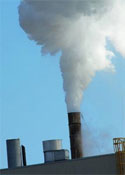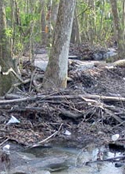Sources of Pollution
Water pollution is when additions to water cause an imbalance in the ecosystem.
There are two main origins of water pollution.
Point Source Pollution
Point source pollution is defined by the U.S. Environmental Protection Agency (EPA) as “any single identifiable source of pollution from which pollutants are discharged, such as a pipe...”
Examples of point sources include:
- discharges from wastewater treatment plants;
- operational wastes from industries; and
- combined sewer outfalls.
State and federal requirements have largely eliminated this type of pollution.
Non-Point Source Pollution
Non-point source pollution does not come from a specific source. Instead, it originates from many places, or from a widespread area. We all contribute to non-point source pollution when we improperly use or dispose of fertilizers, pesticides, oils, grease, pet or animal wastes, and trash. In many communities, including the UF campus, these pollutants are transported to local waterways via storm drains.
As rain flows over campus roads, sidewalks and lawns, it can pick up debris, chemicals, dirt, and other pollutants in its path. This stormwater is NOT cleaned before it reaches campus creeks and lakes that connect to groundwater reservoirs. Both at UF and across the nation, polluted stormwater runoff is one of the greatest threats to clean water.
Examples of non-point sources of pollution include the following:
- Sediments from construction, forestry operations and agricultural lands;
- Bacteria and microorganisms from failing septic systems and pet wastes;
- Nutrients (from fertilizers and yard debris) and pesticides from agricultural areas, golf courses, athletic fields and residential yards;
- Oil, grease, antifreeze, and metals washed from roads, parking lots and driveways;
- Toxic chemicals and cleaners that were not disposed of properly
- Litter thrown onto streets, sidewalks and beaches, or directly into the water by individuals.




